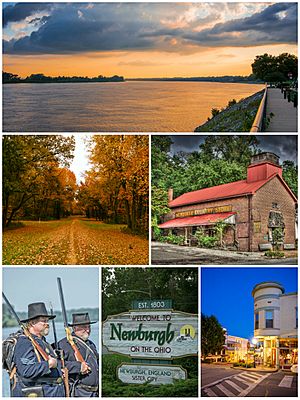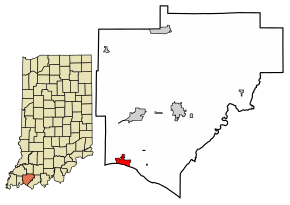Newburgh, Indiana facts for kids
Quick facts for kids
Newburgh, Indiana
|
|
|---|---|

Top to bottom, left to right: Newburgh riverfront, Angel Mounds, Newburgh Country Store, re-enactors of the Newburgh Raid, town welcome sign, and Exchange Hotel
|
|

Location of Newburgh in Warrick County, Indiana
|
|
| Country | United States |
| State | Indiana |
| County | Warrick |
| Township | Ohio |
| Area | |
| • Total | 1.49 sq mi (3.87 km2) |
| • Land | 1.49 sq mi (3.86 km2) |
| • Water | 0.00 sq mi (0.00 km2) |
| Elevation | 400 ft (100 m) |
| Population
(2020)
|
|
| • Total | 3,344 |
| • Density | 2,241.29/sq mi (865.31/km2) |
| Time zone | UTC-6 (Central (CST)) |
| • Summer (DST) | UTC-5 (CDT) |
| ZIP codes |
47629-47630
|
| Area code(s) | 812 |
| FIPS code | 18-52650 |
| GNIS feature ID | 2396812 |
Newburgh is a town in Warrick County, Indiana, United States. It is located right along the Ohio River. In 2020, about 3,344 people lived there. Newburgh is also part of the larger Evansville area. It is the easternmost suburb of Evansville.
People have lived in this area for at least 10,000 years. For example, Angel Mounds was a large village of the Mississippian culture from 1000 AD to about 1400 AD. By 1850, Newburgh was a very busy riverport. It was also the first town north of the Mason–Dixon line to be captured by Confederate soldiers during the Newburgh Raid in the American Civil War. After the mid-1800s, Newburgh's growth slowed down. But in the 1960s and 1970s, it grew a lot as families looked for new homes near Evansville.
Today, Newburgh is known for its historic downtown area. This area has many unique stores, antique shops, and restaurants along the river. The town is still a popular place for people who work in or near Evansville to live.
Contents
Newburgh's Rich History
Newburgh is on the banks of the Ohio River, which means it has a very long history. Explorers from Europe first came to this area in the 1600s. Before that, the Shawnee people lived here. It was also near the center of the ancient Mississippian culture until about 1450 A.D. You can still see proof of this ancient society today at Angel Mounds, which is a National Historic Landmark. The Ellerbusch site is also nearby. Both are about two miles west of Newburgh.
How Newburgh Was Founded
The main founders of Newburgh were John Sprinkle and Abner Luce. John Sprinkle was a businessman who arrived in Newburgh in 1803. This was 13 years before Indiana became the 19th state in the U.S. He bought land in 1812 and in 1818, he planned out a town called Sprinklesburgh. This was the first town in Warrick County. The original Sprinklesburgh was about 12 blocks west of where downtown Newburgh is today.
Abner Luce started Newburgh in 1829, just east of Sprinklesburgh. In 1841, Luce's town joined with Sprinklesburgh. The combined town was then called Newburgh.
Growth and Challenges
By 1850, Newburgh had become one of the biggest riverports on the Ohio-Mississippi River. It was a major stop between Cincinnati and New Orleans. Its growth was helped by coal mining and its great location on the Ohio River. The first underground mine in Indiana was dug in Newburgh in 1850. However, when the national railway system came to southern Indiana, it did not go through Newburgh. Instead, it went through Evansville. This started a big shift in which city was more important for business.
The Newburgh Raid
Newburgh was an important stop on the Underground Railroad. This was a secret network that helped enslaved people escape to freedom. On July 18, 1862, Newburgh became famous during the American Civil War. It was the first town north of the Mason-Dixon line to be captured by Confederate soldiers. This event is known as the Newburgh Raid. Colonel Adam "Stovepipe" Johnson and his group crossed the Ohio River. They took supplies and ammunition without anyone firing a shot. The Confederates had fake cannons made from a stove pipe and a charred log. This raid made the U.S. government realize they needed to send Union Army soldiers to Indiana to stop future attacks. Many buildings from this time are still standing, like the Exchange Hotel.
Modern Development
Newburgh's economy also got a boost from the building of Lock and Dam 47 in the 1920s. This was replaced in 1974 by the Newburgh Lock and Dam. The town also benefited when the Aluminum Company of America (ALCOA) plant was built nearby in 1957. Many people who live in Newburgh today travel to work in Evansville and other nearby areas.
In 2005, a large tornado hit nearby Evansville. Newburgh had a lot of property damage and some injuries, but thankfully no one died.
The Old Newburgh Presbyterian Church and the Original Newburgh Historic District are special places. They are listed on the National Register of Historic Places because of their importance.
Newburgh's Geography and Architecture
Newburgh is located at 37°56′48″N 87°24′13″W / 37.946579°N 87.403735°W. The town covers about 1.41 square miles (3.65 square kilometers) of land.
The Ohio River forms the southern border of Newburgh. Much of the town is safe from floods because of locks and dams built in the 1960s. A notable place to the west is the Angel Mounds Historic Site. This was an ancient burial site that was left empty centuries ago.
Architectural Styles in Newburgh
Many of Newburgh's important buildings are in the Original Newburgh Historic District. These buildings were mostly built between 1850 and 1930. Many of them are recognized for their historical or architectural importance. The town's buildings show different styles, such as Italianate, Greek Revival, and Classical Revival.
Newburgh's Climate
The weather in Newburgh has hot, humid summers and cool to mild winters. It has a humid subtropical climate, which means it gets a good amount of rain throughout the year.
Population of Newburgh
| Historical population | |||
|---|---|---|---|
| Census | Pop. | %± | |
| 1850 | 526 | — | |
| 1860 | 999 | 89.9% | |
| 1870 | 1,464 | 46.5% | |
| 1880 | 1,282 | −12.4% | |
| 1890 | 1,046 | −18.4% | |
| 1900 | 1,371 | 31.1% | |
| 1910 | 1,097 | −20.0% | |
| 1920 | 1,295 | 18.0% | |
| 1930 | 1,262 | −2.5% | |
| 1940 | 1,374 | 8.9% | |
| 1950 | 1,324 | −3.6% | |
| 1960 | 1,450 | 9.5% | |
| 1970 | 2,302 | 58.8% | |
| 1980 | 2,906 | 26.2% | |
| 1990 | 2,880 | −0.9% | |
| 2000 | 3,088 | 7.2% | |
| 2010 | 3,325 | 7.7% | |
| 2020 | 3,344 | 0.6% | |
| U.S. Decennial Census | |||
Newburgh's Population in 2010
In 2010, there were 3,325 people living in Newburgh. There were 1,455 households and 935 families. The town had about 2,358 people per square mile (910 people per square kilometer).
Most of the people in Newburgh were White (94.2%). There were also smaller numbers of African American (1.4%), Native American (0.1%), and Asian (2.0%) residents. About 2.0% of the population was Hispanic or Latino.
The average age in Newburgh was 42.1 years old. About 22.4% of residents were under 18. And 14.4% were 65 years old or older.
Education in Newburgh
The Warrick County School Corporation serves the town of Newburgh. This is the only school district in the county. There are four elementary schools, two middle schools, and Castle High School. All of Newburgh's public schools have received an "A" grade from the Indiana Board of Education, which is the highest possible.
Before 1959, Newburgh had its own high school. Its colors were navy blue and old gold, and its mascot was the Wildcats. In 1959, it joined with Castle High School.
Newburgh also has two public libraries that are part of the Ohio Township Public Library System. The first branch opened in 1916 as a Carnegie library. In 2017, the library joined a group called Evergreen Indiana. This allows people to borrow books from over 100 libraries across Indiana.
Cultural Features and Events
Several blocks of Main Street in Newburgh have been designed to look like a historic "river town" village.
Every summer, Newburgh hosts several fun festivals:
- A Wine, Art & Jazz Festival
- Fiddler Fest
- The Strawberry Festival
Some events happen by the river, near the town's lock and dam. Others are held in the old downtown area. Summerfest is another popular event held in June.
In the fall, the historic downtown group hosts "Ghost Walks." During these walks, people learn about the town's history of mining, the Civil War, and the Underground Railroad. In early December, there's a downtown Christmas celebration. Over 60 people dress in old-fashioned costumes, and there are carolers and street musicians. You can also take trolley tours, take photos with Santa, and watch the Newburgh tree lighting ceremony.
Newburgh has several parks. There's also a path for bikes and walking along the riverfront. There are plans to connect this path to Evansville's trail system. In 2006, a big golf tournament, the United States Senior Men's Amateur Golf Championship, was held near Newburgh at the Victoria National Golf Course.
Transportation
The Warrick Area Transit System (WATS) provides bus service. This connects Newburgh to the bus system in Evansville.
Notable People from Newburgh
Many interesting people have connections to Newburgh:
- William Bartelt – A historian and author known for his work on Abraham Lincoln's youth in Indiana.
- Jamey Carroll – A professional Major League Baseball player.
- Ernie Haase – A musician who grew up in Newburgh.
- Mock Orange – A band.
- Michael Rosenbaum – An actor, known for his role in Smallville.
- Marcia Yockey – A local television weather personality.
- Lily K. Donaldson – Miss United States 2022.
Sister City
Newburgh has one sister city. This is a special friendship between two towns in different countries:
 Newburgh, Lancashire, United Kingdom
Newburgh, Lancashire, United Kingdom
See also
 In Spanish: Newburgh (Indiana) para niños
In Spanish: Newburgh (Indiana) para niños


